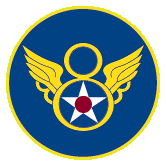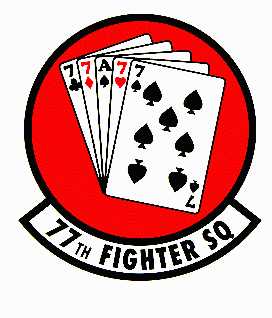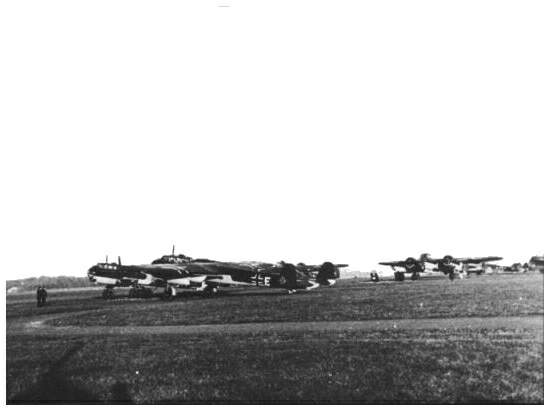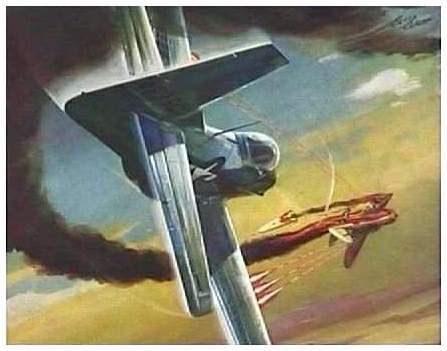 THE 77TH. CLAIM A RECORD
THE 77TH. CLAIM A RECORD
Article Courtesy of David G. Knight
 Oil and important rail transportation were the targets for 876 B17s and
B24s attacking Magdeburg Lutzkendorf Bohlen Bielefeld and Altenbeken. Lt
Col. Gustke led the 20th Group on an uneventful escort of 1st Air
Division bombers to the oil refineries at Lutzkendorf.
Ten minutes after target time, Maj. Gilbertson led the 77th Squadron
down to a lower altitude in a planned search for targets to strafe on
the way out leaving the rest of the group to complete the escort.
Oil and important rail transportation were the targets for 876 B17s and
B24s attacking Magdeburg Lutzkendorf Bohlen Bielefeld and Altenbeken. Lt
Col. Gustke led the 20th Group on an uneventful escort of 1st Air
Division bombers to the oil refineries at Lutzkendorf.
Ten minutes after target time, Maj. Gilbertson led the 77th Squadron
down to a lower altitude in a planned search for targets to strafe on
the way out leaving the rest of the group to complete the escort.The first target presented itself east of Esperstedt. Gilbertson leading white flight in an attack on a long freight train. Although they destroyed the locomotive, the freight cars refused to burn despite several firing passes by the P-51s. Soon afterwards Lt Fred Larsen, flying Yellow Four, spotted at least eighty aircraft parked on the airfield at Esperstedt, three quarters of which were single engine types (mostly FW-190s) the rest being twin engine aircraft. Calling these targets in Larsen made an initial pass on one of the aircraft which blew up. The rest of the squadron then moved in and strafed the field for 20 minutes from 1315 to 1335 hours; making one pass from east to west, two passes from north to south and as many as five passes were made by some pilots from south to north. Maj. Gilbertson made several passes on the field and destroyed three FW190s. One of which exploded sending a piece of flying debris through the canopy of his P-51 causing several cuts to his face. There were many light flak emplacements south of the field and dispersal areas as well as on the eastern side and in the southwest and northeast corners.
Although the light flak was very intense it was not accurate and thirty eight planes were destroyed on the ground and five damaged. Four hangers, one large and three blister type, were destroyed and two damaged. In addition a gun emplacement and one admin building were damaged. All the planes, especially the FW-190s, appeared to be brand new and readily burst into flames. One pilot who met with considerable success was Capt Lowell Einhaus, flying Yellow Lead in P-51D 44-13918 LC-V:

Luftwaffe airfields such as this made tempting targets for 20th. Fighter Group pilots.
"I made several passes on the airfield, all of them starting from around
1500 to 2000 feet. I came down to about fifty to a hundred feet and my
speed must have been between 300 and 375 mph. My first pass was from
south to north and I strafed three FW190s on the western side of the
field. I observed strikes on all the aircraft, two bursting into flames
and one smoking. I chandelled up to the left after this and came back
again from the same direction for a second pass. This time I fired at
one FW190 in a hangar in the dispersal area south of the field. The 190
burst into flame and the whole hangar had caved in and both the plane
and the hangar were burning violently. On the same pass I finished off
the plane that was smoking as a result of my initial attack. The
aircraft blew up as I passed fifty feet above it the explosion forcing
my P51 into a half snap roll. On my third pass I came in again from
south to north and this time fired at an FW190 parked in the southwest
corner of the field near a hangar. As I pulled off from this pass I flew
a little to the left and let go a short burst into a barracks area. For
my fourth pass I picked out an FW190 right next to the previous one and
again this was burning as I passed over it.
"I made several more passes on the field but by this time my guns were
running short of ammunition and were firing sporadically. In the end I
believe it was only my right wing guns that were firing. During these
passes I sprayed the general area noticing a few hits on various
aircraft but did not claim any of these. During a further pass on the
barracks area about eight Germans ran across my line of fire towards the
barracks and six of them were caught in the burst from my guns. My
wingman Lt. William Fay and I were the last to leave the field and I
counted thirty plus fires as I circled over the airfield before we
left."
Vintage ad showing a P-51 Mustang at work
As the 77th pulled up off target at about 1340 hours a group of Me-109s
began making several passes on the climbing P-51s as they tried to
regroup. From the timing of the Germans' attack it would seem that they
had been accurately vectored into a position to attack the 77th. Despite
being somewhat surprised by the Germans attack the squadron did destroy
two of these 109s and damaged another in the ensuing dog-fights. Lt
Phillip Schallo, flying White Three in P-51D 44-14975 LC-K, was the first
to score against the 109s:
Unless otherwise noted, all content © copyright The Art of Syd Edwards 1998-1999. All rights reserved and reproduction is prohibited.
"After our attack on Esperstedt Airfield I pulled off and started
climbing through a break in the clouds, hoping to join up with the rest
of the squadron. While passing three thousand feet I saw an Me-109
spinning down towards the ground and realised enemy aircraft were in the
vicinity. I immediately poured on the coals and climbed as fast as
possible. At about nine thousand feet I saw a 109 making a head-on pass
at Lt Starke's P-51. I turned toward the 109 and opened fire at two
hundred yards with sixty degree deflection and noticed many strikes in
the cockpit area. As I slid by the 109 racked round and started
spinning. I watched the plane until it went into the ground and
exploded.
"I saw another 109 after a P-51 and pulled over after him, firing a long
burst at four hundred yards but noticed no strikes. Looking back to
clear my tail I saw another 109 firing at me. I broke to the right and
found myself in the middle of approximately twelve more 109s! I kept
breaking and turning for about ten minutes but never got a chance to
shoot. Finally, seeing an opening to the west, I put my nose down and
ran for home; ducking into clouds at the first opportunity."
The second 109 fell to the guns of Lt Glen Hall flying White Four in
P-51D 44-14824 LC-P:
"I was climbing away from the airfield and had reached somewhere between
nine and twelve thousand feet, when I saw eight plus 109s at eleven
o'clock to me two thousand feet above. They dropped their tanks and were
preparing to make a pass on the six P51s in front of me that I was
trying to join. As they made their attack the 51s broke. I saw one go
into a steep dive to the right with a 109 after him. I broke and gave
chase. He must have realised I was after him because as the P-51 broke
right the 109 broke left. He then split-essed and pulled out with a
sharp right turn. I had followed him through these manoeuvres and gave
him two or three short bursts from five hundred yards as he broke right
noticing several hits around the canopy. As he flipped left I again hit
him. I think my first burst must have killed the pilot because the plane
just rolled over and went straight down and crashed into the ground. The
pilot made no attempt to get out, his canopy not even coming off."
Lt Frank Purse's P-51D 44-15379 LC-N was one of the six that Hall was
attempting to join:
"I broke to the right as about ten 109s came through us at twelve
o'clock, taking a short burst at one head on with no observed results.
The enemy planes were dispersed and I started home with my wingman Lt
Kerns. We had been headed 260 degrees for about ten minutes, with four
other P-51s which had joined us and were flying at five o'clock to us.
Suddenly someone called for a break. I looked around and these four P-51s
were being bounced by fifteen or so 109s from six o'clock high. I made a
break to the right and picked out one of the 109s which was making a
tight climbing turn to the left. I started cutting him off and closed to
within five hundred feet of him while firing a long burst. I observed
strikes near the left wing-root and then had to stop shooting as my
plane had stalled out. As I was breaking the stall my wingman called for
me to leave in a hurry because about five 109s were on our tails
shooting at us. Just as he called for me to leave the 109 that I had
fired at made a very slow roll to the left and split-essed towards the
clouds. After the plane pulled out of the dive, it started a diving
spiral to the right and appeared to be out of control. My wingman and I
then left the area since the rest of the 109s were ganging up on us."
Lt Purse claimed this 109 as damaged, probably destroyed.
The 77th attack on Esperstedt had achieved complete success and set a
new record (for the time being) for the number of enemy aircraft
destroyed on the ground by an Eighth Air Force squadron.
77th Squadron pilots who flew mission 258:
____________________
White Flight: Gilbertson, Starke, Schallo, Hall; Yellow Flight: Einhaus,
Fay, Jones, Larsen; Red Flight: Cole, King, Reynolds, Pitz; Blue Flight:
Jennings, Nuno, Purse, Kerns.
____________________
Enemy Aircraft claims made by 77th Squadron pilots on mission 258:
Pilot Serial & Codes of Acf Claim:
Maj. Gilbertson (44-14822 LC-A) Three FW190s destroyed. One ME109 damaged.
Lt. Starke (44-13803 LC-P) One FW190 destroyed. One ME410 destroyed.
Lt. Shallo (44-14975 LC-K) Two FW190s destroyed. One ME410 destroyed.
Lt. Hall (44-14824 LC-P) One FW190 destroyed. One ME410 damaged. One ME109
destroyed (air).
Capt. Einhaus (44-13918 LC-V) Six FW190s destroyed.
Lt. Fay (44-11566 LC-Q) Three FW190s destroyed.
Lt. Jones (44-14823 LC-F) Three FW190s destroyed. One ME109 destroyed.
Lt. Larsen (44-15605 LC-M) Two FW190s destroyed. One s/e biplane destroyed.
Capt. Cole (44-11324 LC-U) Six FW190s destroyed. One FW190 damaged.
Lt. Reynolds (44-15321 LC-S) Two FW190s destroyed. Two ME110s destroyed.
Lt. Pitz (44-14598 LC-L) Two FW190s destroyed. One ME110 damaged.
Capt. Jennings (44-13798 LC-W) One FW190 destroyed.
Lt. Purse (44-15379 LC-N) One ME109 damaged (air).
In addition the following ground targets were destroyed or damaged:
One
locomotive destroyed -Maj. Gilbertson
Four hangars destroyed - Capt.
Einhaus, Lt. Jones, Lt. Larsen (two)
Two hangars damaged - Capt. Einhaus
One admin building damaged - Capt. Einhaus
One gun emplacement damaged -
Capt. Jennings
Twenty freight cars damaged -White Flight.
RETURN TO MISSIONS PAGE RETURN TO 20TH. FG
